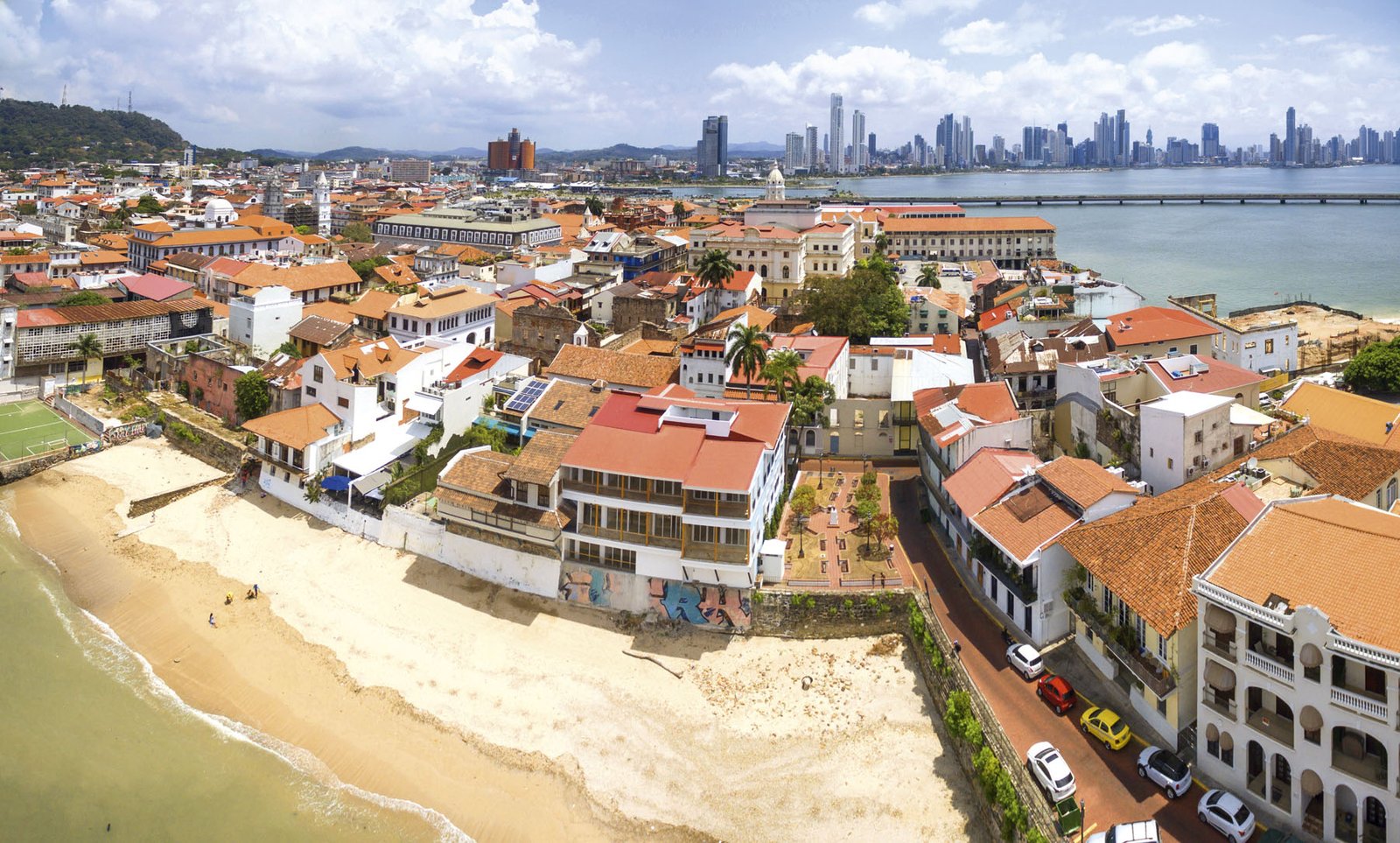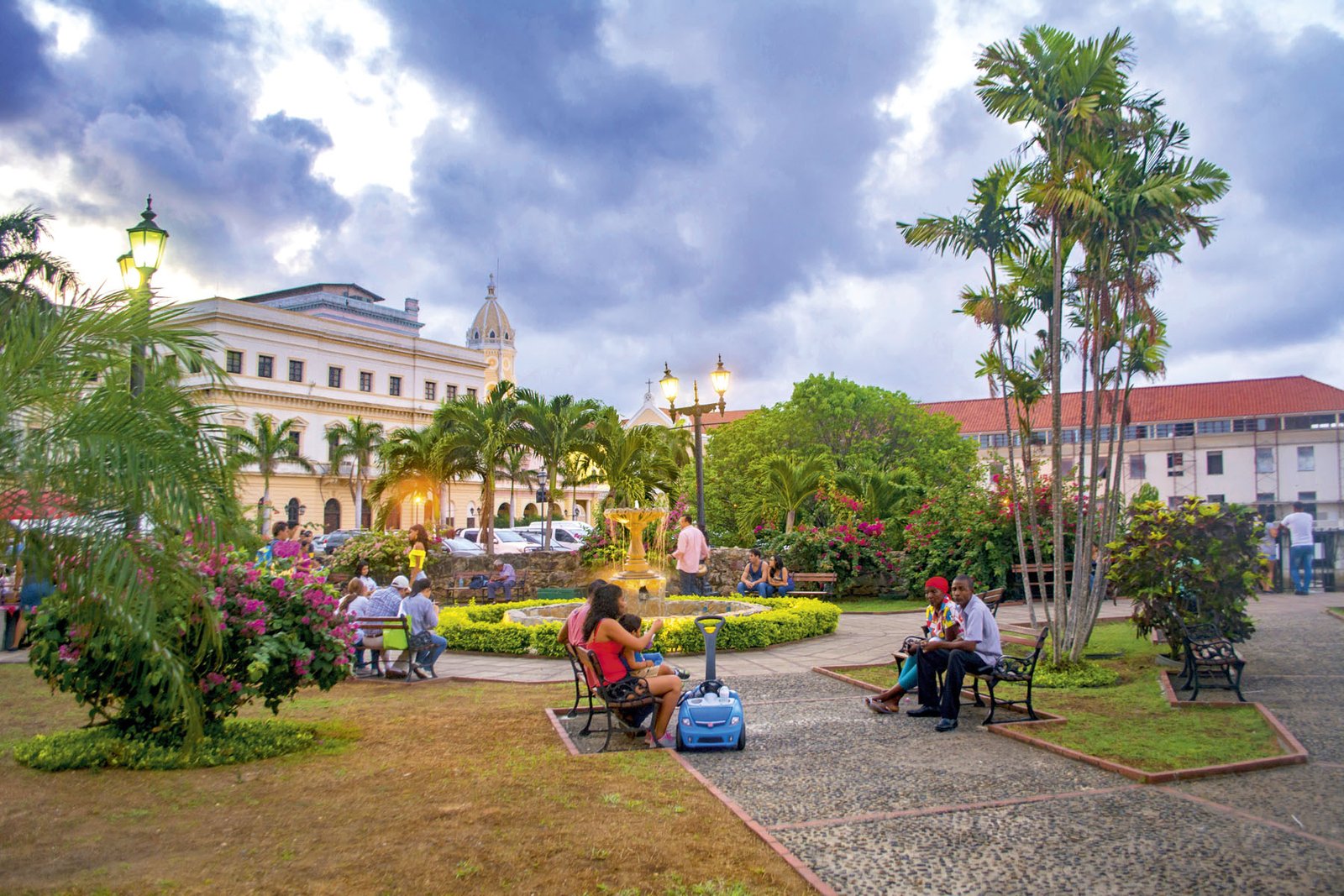
The Charms of the Casco Viejo
By Ana Teresa Benjamín
Photos: Javier Pinzón
A few years ago, in Panama City’s Casco Viejo (Old Quarter), there was a student dormitory that looked like it was frozen in time. Most of its structure “hung” over the ocean, while in the study area a cold salt wind blew, like a fugitive from a children’s story.
At that time, the Casco Viejo was a depressed area. Its former residents had abandoned it decades earlier to move to newer, larger areas with better infrastructure. The old walled city remained in a limbo of poverty and disappointment. Nevertheless, it was a delight to spend a Sunday afternoon along the Paseo Esteban Huertas, savor a raspa’o in the Plaza de la Independencia, or participate in the cultural and recreational activities that took place in the ruins of the colonial buildings.

The area’s reality began to change in 1997, when the government of Panama enacted a law promoting incentives for the restoration of buildings in the Casco Antiguo. The law was very important from an economic and heritage point of view, because it recognized the neighborhood’s historical importance. The Casco Viejo was the second settlement of Panama City. It´s construction began in 1673 after the first settlement was reduced to ashes by the English pirate Henry Morgan in 1671. That first settlement is known today as Panama La Vieja.
Almost twenty years after the law, the restoration continues at a frenetic pace and not without criticism, because many of the older residents have had to move because of the rising property prices.
According to Manuel Choy, architectural restoration specialist from the firm Arquitechne, a square meter in the Casco Viejo sells for around $2,500 to $3,000, one of the highest rates in Panama City, comparable only to prices in the upscale neighborhood of Costa del Este.

Official data from the Office of the Casco Antiguo (OCA) indicates that only 30% of the properties in the area —which extends to the areas of Santa Ana and El Chorillo— have been restored, which gives you an idea of the real estate fervor currently prevailing.
Enjoying the Neighborhood
What I most enjoy about the Casco Viejo is its light. Perhaps because it’s by the sea or because of the way the sun slips easily between its low lying buildings, but anyone walking around the neighborhood will be captivated by the sunset falling over the Bridge of the Americas and astounded by the color of the stones in the ruins of the religious buildings. Visitors will become immersed in the feast of colors of the facades adorned with bougainvillea, imagining the history of the walls and windows through the paintings and broken forges.

Let’s start at the Plazoleta Medio Baluarte (or Baluarte de las Monjas), next to the Government Ministry (former National Palace), built between 1905 and 1908 and designed by the architect Genaro Ruggieri, who was also responsible for creating the concept of the adjacent building, the National Theater. The small square, featuring a small fountain in the center and the very modern Balboa Avenue and Punta Paitilla, is a good place to start. You can take panoramic photos before heading towards the Paseo Esteban Huertas promenade, which is covered with bougainvillea.
Between the square and the avenue is the old Club Unión (later the Club de Clases and Tropas), which is being remodeled and converted into a hotel. At the foot of the stairs leading to the avenue is a handicrafts shop, the only pharmacy in the neighborhood, and several formal and casual restaurants for all budgets and culinary preferences.
The Paseo Esteban Huertas is a large promenade built along the Baluarte de Chiriquí, one of the best-preserved parts of the colonial wall, built in the 17th century to defend against pirates. In this space, which invites you to relax, there are several stands selling souvenirs and handicrafts. From the promenade, you can access the Casa del Soldado, which offers exhibitions, talks, workshops, and film screenings.

Watch out for informational plaques, since one of the historical points of interest along the promenade is the exact site where, in 1903, the Liberal leader Victoriano Lorenzo was shot. Lorenzo fought against the central power of Colombia —when Panama was a province of the old country— during the Thousand Days War, hoping to improve the conditions of Panama’s indigenous and peasant populations. At the end of the war he was betrayed and executed, but the memory of his life remains here, in the Plaza de Francia.
The Plaza de Francia was the Plaza de Armas of the Chiriquí Barracks (Cuartel de Chiriquí). It acquired its name in the 1920s, when it was converted into a monumental space. Its vaults, which served as a jail, depository, and dormitories, now evoke the French odyssey to build a sea-level canal at the end of the 19th century. In fact, facing the plaza is the French Embassy, as well as the National Institute of Culture (formerly the National Palace of Justice). Leaving the Plaza de Francia, we encounter the Plaza Carlos V, built in honor of the first king to conceive of the idea of building a canal across the Isthmus of Panama.
On the Opposite Side

Across from the Paseo Esteban Huertas and the Plaza de Francia is the entrance to the Casco Viejo, which borders Santa Ana: the old suburb. The entrance is along the neighborhood’s Central Avenue, which displays buildings worthy of being admired: the Municipal House and, to its side, the Church of La Merced, the façade of which is the same as it was in the first city. How did it get to the new settlement? Well, when Morgan’s attack ended, many of the stones from the church’s buildings were used to build the walls of defense, but the façade was preserved and moved stone by stone, to the new site.
The Church of La Merced is currently being restored. The gates are new, the original ceiling is being restored, the choir area has been rebuilt, and an organ has been installed. The church is very popular in the neighborhood because it contains some of the most revered saints: Our Lady of Charity, (Virgen de la Caridad del Cobre), the Divine Child Jesus, and St. Eduviges, whose followers come seeking shelter.

If you take Calle 9 from La Merced, you will reach another of important plaza: the Plaza of Tomás Herrera. The story goes that in 1781 a fire razed all the homes, leaving an empty lot. For some time the area was used for bullfights and in 1887 it received its present name.
What should you absolutely not miss when visiting? The Casa Boyacá, built around 1890 and restored in 2005, is one of the few homes rebuilt to rent to low and medium-income families. Its uniqueness lies in the triangular shape of its architecture. The back wall is “supported” by another section of the wall of the old city. A few blocks further down, on Avenue A, is the Church of San José, the main attraction of which is the so-called “golden altar,” capable of blinding anyone who enters its nave after a few hours of walking under the bright sun.
As the story, or the legend, depending on how you view it, goes, when the monks realized Morgan was approaching, they protected the golden altar by covering it with mud. In reality, the altar is made of carved mahogany covered with gold leaf. Along the same avenue are the ruins of the Society of Jesus (Iglesia de la Compañía de Jesús) —the oldest church in the Casco— and the Convent of Santo Domingo, built in 1678.

If you continue walking straight, you will once again reach the Paseo Esteban Huertas. But if you go up Calle 7, you will arrive directly at the Plaza de la Independencia, where the best time is early May, when the Guayacan trees flower and the plaza turns into a carpet… not of butterflies but of yellow flowers.
The plaza is used on Sundays —when vehicular traffic is only permitted on the peripheral streets— to house a bazaar with artistic and cultural presentations. Facing the plaza is the Metropolitan Cathedral (Catedral Metropolitana), the Casco’s most iconic building, the construction of which began in 1688 and ended in 1796. It is currently under restoration, which promises to return it to its former splendor and make it part of the tourist circuit of churches in the Casco Viejo. There are five churches in total. In fact, the last church to open its doors to the public is San Francisco de Asís, opposite Plaza Bolívar: the hippest in the neighborhood.
The current image of the San Francisco de Asís church dates from 1918 and its reopening is a cause for joy, considering it was abandoned for a decade. Adjacent to the church is the Palacio Bolívar —seat of the Ministry of Foreign Relations. Around the square is a wide array of restaurants, which are best in the evening. The National Theater is also there, currently closed for remodeling, and the Church of San Felipe Neri, the smallest in the area.
After the Casco Viejo’s architectural and historic wealth, the atmosphere of the area is the best part. This atmosphere is evident not only in the nightlife in its bars, restaurants, and the Anita Villalaz Theater, but also in the spirit that pervades the hundreds of officials who work at the nearby ministry offices or at the Presidency of the Republic. The feeling is also in the schools: every day at noon, for example, a seemingly endless cluster of young children appear from the Escuela República de México School at the end of their school day. And you find yourself walking through the Casco behind mothers holding hands with their children, taking them back home.

That’s when one thinks, as Rebeca Somoza de Burgos, the director of the OCA says, that the Casco Viejo of Panama City is a heritage site of undeniable wealth, memory, and leisure possibilities, but above all spirit, the kind that suffuses all the people who walk and breathe along its streets.